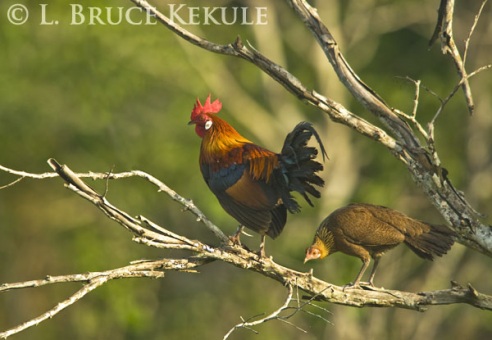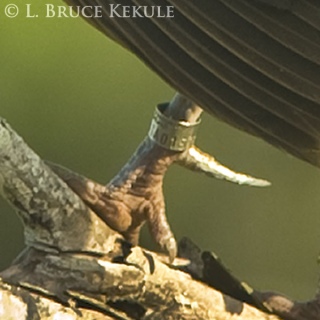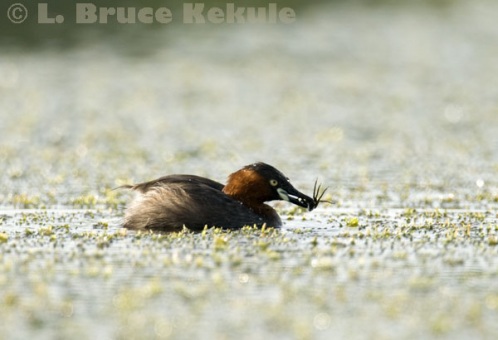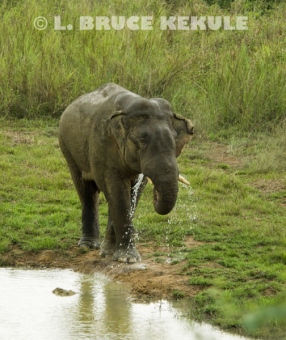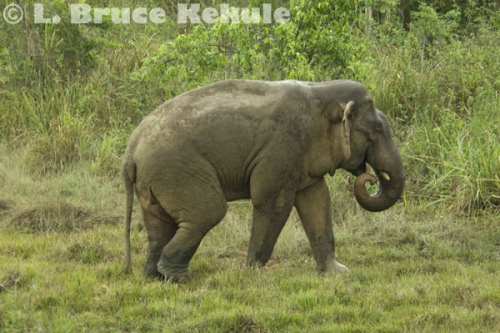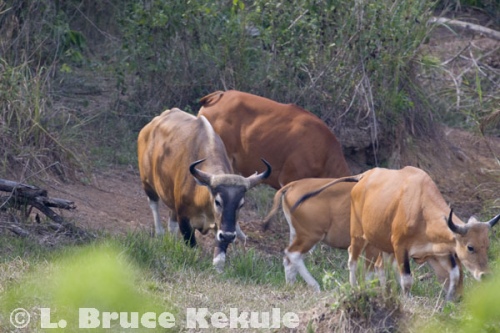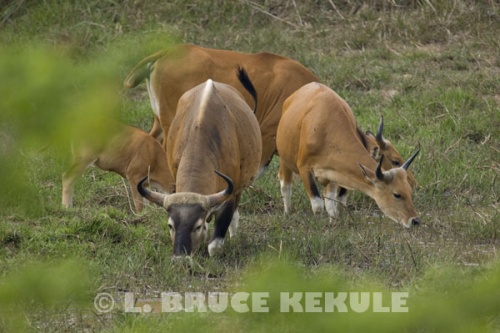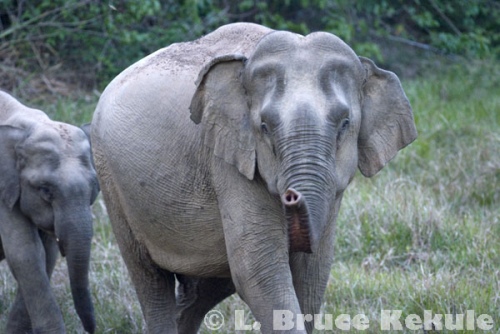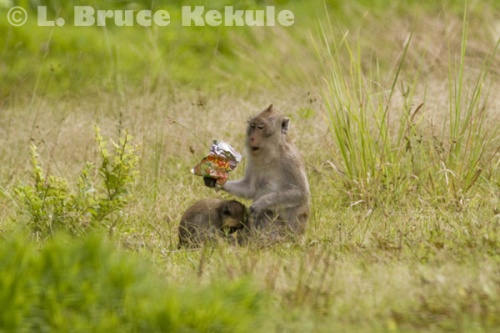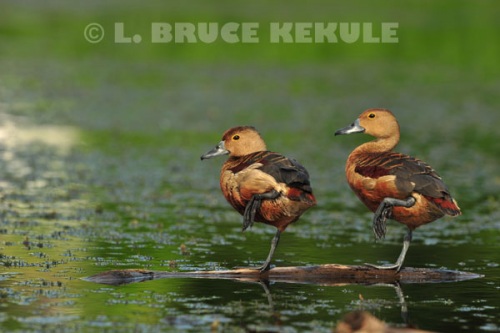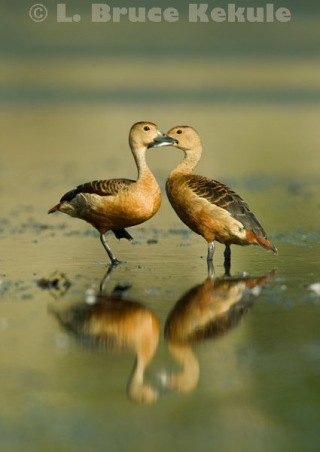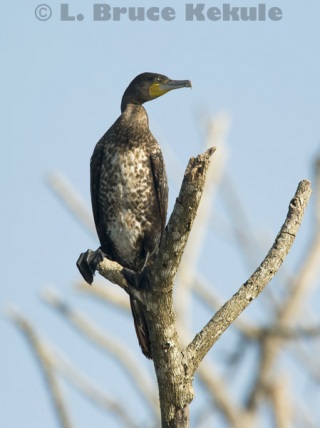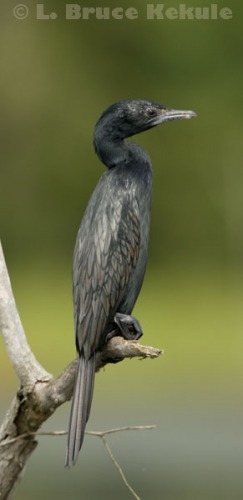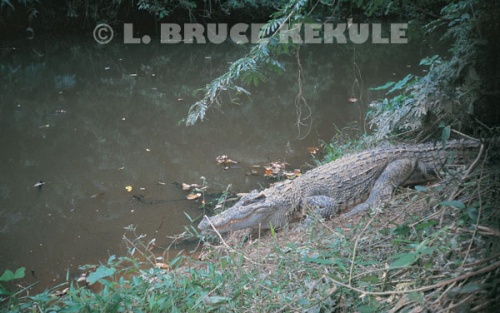Posts Tagged ‘Khao Ang Rue Nai’
Red Jungle Fowl – Wild ancestor of the domestic chicken
WILD SPECIES REPORT : Endangered Asian Galleopheasants
Red jungle fowl in Khao Ang Rue Nai Wildlife Sanctuary
It is 3am in lowland dry evergreen forest of Khao Ang Rue Nai Wildlife Sanctuary in eastern Thailand. Close by, a familiar sound is heard waking me up from sleep in my hammock. I’m at the wildlife research station close to the headquarters area of the sanctuary during the breeding season. A male red jungle fowl Gallus gallus has just emitted the well known ‘cock-a-doodle-do’ on the hour as its kind has for thousands of years.
These birds are quite common in Khao Ang Rue Nai that borders Khao Soi Dow Wildlife Sanctuary in the Southeast, and is a haven for this Galleopheasant. It has been determined the species is the ancestor to the domestic chicken.
Red jungle fowl male taking off from tree branch
After a quick cup of coffee, I ready my photographic equipment and head out into the bush about 6am at first light with my main lens and camera mounted in the window of my Ford pick-up. I have photographed many animals this way by driving around and when a subject is found, my camera is ready for instantaneous use. As long as I stay in the truck, it is possible to catch many birds, mammals and reptiles in their natural environment.
On this particular morning as I was on the road near a man-made reservoir in the protected area, the sun was just peaking over the distant mountains when I flushed a male and female jungle fowl. They flew to a tree about 50 meters away and stayed for a short while as I fired off a long series of photos. But the male was seriously in love and did not pay me any attention as I edged the truck closer for some full-frame shots of the pair. Then the female took flight, and the cock-in-love chased after her but I was ready catching him in mid-flight just off the branch.
Red jungle fowl male with leg band
A close look at the lead photograph will reveal a band around the male’s left leg. This bird was part of a scientific survey carried out by my very close friend and associate Dr Sawai Wanghongsa, and his staff at the wildlife research station at Khao Ang Rue Nai. The rooster was three to four months old when captured about 500 meters away the previous year, and was now full grown and breeding when this photograph was taken in 2009.
But the amazing thing, I could read some of the numbers on the band after enlarging to extreme size in the computer shown in the inset, and Sawai correlated his data about this particular bird. It certainly was a lucky set of photographs including the flying shot of the wary jungle fowl. He has written several scientific papers on the species.
Red jungle fowl in Huai Kha Khaeng WS – A band of cocks
Two sub-species of red jungle fowl live in Thailand. Gallus gallus spadiceas is found on the western flank from the North all the way down to Malaysia, and in the east lives G. g. gallus. The only distinct difference between these two is a white spot on the ear pad belonging to the eastern species, and a red pad on western birds.
Dr Sawai works for the Department of National Parks and collaborates with Japanese scientists including H.I.H. Prince Akishino-no-miya Fumihito of Japan who is studying the relationship between red jungle fowl, domesticated chickens, and the impact humans has upon the wild species. Dr Yoshihiro Hayashi and others with the University of Tokyo and Professor Wina Meckvichai with the Department of Biology at the Faculty of Science, Chulalongkorn University in Bangkok are also involved in the project.
Red jungle fowl male and females in Huai Kha Khaeng WS
Between 2005 and 2009 they conducted intensive research on the ecology of red jungle fowl in Thailand for the royal multi-disciplinary research project entitled ‘Human-Chicken Multi relationship Research Project (HCMR)’ initiated by Prince Akishino under the royal patronage of H.R.H Princess Maha Chakri Sirindhorn of Thailand.
They concentrated their studies in Wat Prathat Mae Jedee in Wiang Papao district of Chiangrai province, northern Thailand where the red ear-lobed jungle fowl thrives in strips of forested areas sandwiched between temples and villages where domestic chickens are raised. Parallel studies were also carried out in Khao Ang Rue Nai Wildlife, where the white ear-lobed jungle fowl exist but are more isolated from villages and people. They have gained much evidence about the domestication of chickens. A new program is now underway to further their knowledge and understanding.
Red jungle fowl in Khao Ang Rue Nai WS infested with ticks
Charles Darwin in 1875 speculated that red jungle fowl was the wild progenitor of all domestic chickens and proposed that Southeast Asia was the origin of domestication. Later, genetic evidence supported the Darwin hypothesis in that this species was the main ancestor of domesticated chickens (Fumihito et al. 1994, 1996), and domestication took place somewhere in Southeast Asia, especially Thailand and neighboring areas some 8,000 years ago. Cave paintings revealed chickens were portrayed on a single cave wall in Khao Pla La, Uthai Thani province dating back 2500-3000 years ago.
Prince Akishino was recently in Thailand and granted a Royal Audience by H.M King Bhumibol Adulyadej. Then, the Prince visited Department on National Park (DNP) officials including Sunan Arunnopparat, the Director General who presented a framed copy of the lead photograph to the Prince. It was certainly a great honor for me as the photographer.
Red jungle fowl in Khao Ang Rue Nai WS infested with a tick
Another interesting set of photographs I acquired in Khao Ang Rue Nai of red jungle fowl is a rooster infected with ticks with a large tick on one side latched on to his waddle, and a smaller tick with a load of little ticks on the other side. Males normally have a red crest but this bird looked like it had lost most of its color and was seemingly rather pale.
This was during the dry season and ticks are everywhere latching on to anything that provides blood. It definitely is a dangerous time for human beings as some ticks have harmful viruses that can make one very sick, and has killed people that contracted Lyme’s disease through tick bites. I dread the little critters and get rid of them as soon as possible if they latch on to my skin. I once had one on my left shoulder after visiting Nam Nao National Park in Phetchabun province that became really infected before I got rid of it, and the swelling and itchiness lasted for months.
The Prince of Japan being presented a framed photo by the Director General of the Department of National Parks
Over on the western side of Thailand in Huai Kha Khaeng Wildlife Sanctuary, red jungle fowl are also very common in this World Heritage Site. I am sitting in my battery powered boat-blind up-river about five kilometers from the southern boundary at Krueng Krai ranger station. The sun is bright and warm on this chilly morning. A red jungle fowl male and his harem of two females are pecking the ground for food by the waterway.
I slowly and silently ease the boat closer to get some frame-filling shots of the group. Again, the cock was only interested in the hens and I was able to get quite close. These birds are normally not that easy to photograph.
Prehistorically, the genus Gallus was found all over Eurasia. In fact it appears to have evolved during the Late Miocene/Early Pliocene of Greece and surrounding areas. Several fossil species have been described, but their distinctness is not firmly established in all cases.
As this is about red jungle fowl, the other species like grey jungle fowl G. g sonneratii surviving in India, the Sri Lankan jungle fowl G. g. lafayetii coming from the island of the same name, and green jungle fowl G. g. varius from Indonesia are related.
Male jungle fowl have gaudy iridescent colors but the females come with subtle browns and grays for camouflage. The male have a white rump and legs are grey. The species is found in a wide variety of forest types.
During the breeding season, the dominant male will crow (also known as ek-ee-ek-ek) every hour on the hour. Out of breeding, they only call twice a day, once in the morning and again in the late afternoon. Males form harems in December, and breed from January to May. They nest on the ground and have a clutch of eight to ten eggs. After two months, the chicks will disperse.
The domesticated chicken G. g. domesticus is only mentioned in passing for this story. They of course provide humans with meat and eggs that make up one of our most important protein diets. But now domesticated chickens in close proximity to wild birds have created genetic problems that have arisen in forest jungle fowl at certain locations around the Kingdom.
Nowadays, chickens are involved in many aspects of the normal life of man. Chickens are involved in religious ceremonies as a sacrificial animal, in games as in fighting cocks, in leisure activities as pet bantams, and in the commercial poultry sector as boilers and egg layers. It has been estimated that by 2020, some 83 million metric tons of poultry will be globally consumed every year.
Cock fighting as practiced in the South of Thailand uses specially made daggers that are attached to the rooster’s spur. These extremely sharp weapons are made only from serow horn that has greatly affected this goat-antelope once found in just about every mountain in the Kingdom. Due to hunting for meat and their horns, these unique wild ungulates have also become seriously endangered.
Red jungle fowl is now on the endangered list, and the species like all the rest of the animals living in Thailand’s protected areas need absolute protection. Sweeping changes are needed in its implementation. It seems though the long hard struggle to protect the Kingdom’s forests continues to be an up-hill battle, not only for the DNP, but all the other conservation minded people who love nature. The future of wildlife and the forests remains unclear, and increased budgets, more personnel, better management and education to all levels of society are the key!
Khao Ang Rue Nai – Natural splendor in the East
Thailand’s largest remaining tract of lowland evergreen rainforest and a very important wildlife sanctuary
During mid-morning at a secluded murky stream deep in the Eastern evergreen rainforest, a single reptile glides effortlessly through the water to a favorite basking spot. Lying on the bank some three meters long, this freshwater Siamese crocodile warms-up in the bright sunlight. Judging from the many photographs taken of this individual, it is a mature animal. Sex and actual age are not known, but it has been here for sometime now. The habitat consists of several connecting deep ponds with abundant fish stocks. The crocodile takes occasionally small mammals and birds. It is a lucky but lonely survivor.
Sunrize in Khao Ang Rue Nai Wildlife Sanctuary
During mid-morning at a secluded murky stream deep in the Eastern evergreen rainforest, a single reptile glides effortlessly through the water to a favorite basking spot. Lying on the bank some three meters long, this freshwater Siamese crocodile warms-up in the bright sunlight. Judging from the many photographs taken of this individual, it is a mature animal. Sex and actual age are not known, but it has been here for sometime now. The habitat consists of several connecting deep ponds with abundant fish stocks. The crocodile takes occasionally small mammals and birds. It is a lucky but lonely survivor.
Little grebe in the reservoir
Khao Ang Rue Nai Wildlife Sanctuary is home to probably the last truly wild Siamese crocodile in eastern Thailand. There are just a few surviving in nearby Cambodia but their future is threatened by the construction of hydroelectric dams. Since Siamese crocs can live for 60-70 years, it is hoped this individual will be in Khao Ang Rue Nai for some time to come.
Bull elephant at a waterhole
Kitti Kreetiyutanont, a forest official working in the sanctuary, recorded the first sighting of this individual in 1987 by photograph. The croc still survives to this day, and is a tribute to the tenacity and longevity of the species. However, it is a case in point where humans are to blame for the disappearance of these remarkable creatures, from the lowlands all the way up into the forest; by encroachment, poaching and logging that went on for decades.
Bull elephant on the move
Some 230 million years ago judging from fossil evidence, the first crocodilians evolved from the Archosaur. Crocodiles have outlived the dinosaur but here in Thailand, the demise of the wild species is close at hand. In the past, crocodiles were found in just about every main river system throughout the Kingdom. Modernization has brought these mystical creatures to the brink of extinction. They were mainly captured to stock crocodile farms, and were also killed by the people who mostly feared the sometimes aggressive reptiles. With no laws in place at the time to protect these animals, extinction was imminent.
Banteng herd at a waterhole in Khao Ang Rue Nai
However, a very small reintroduction program could be implemented here, and with increased protection, could work to save the remarkable Siamese crocodile from extinction in the wild. There are several other sites that can also be used for reintroduction such as Yot Dom National Park in Ubol Ratchathani province, and Phu Khieo Wildlife Sanctuary in Chaiyaphum province where crocs were once common. There are thousands upon thousands of crocodiles in farms, mostly by crossbreeding and hybridization. A wild population is the only option. A few of the crocodile farms still have
Banteng herd at a waterhole
Siamese crocodiles taken from the wild and could easily start a program to save the species. There has been one attempt at a national park to release crocodiles but it apparently was abandoned. Also, several Siamese crocodile have mysteriously showed up at Khao Yai and Thung Salang Luang national parks and believed to have been released clandestinely. These crocodiles should be captured and DNA checked to see if they are truly wild crocs.
Banteng cow with a lame right rear hoof
Khao Ang Rue Nai is situated in the provinces of Chanthaburi, Prachin Buri, Chachoengsao, Chon Buri and Rayong. The sanctuary headquarters is located about three hours drive from Bangkok and was established in 1977 by Royal Decree. The protected area consists mainly (80 percent) of dry-evergreen forest with moist and hill evergreen, dry dipterocarp and mixed-deciduous forests interspersed with many streams, and are eastern Thailand’s largest remaining tract of lowland evergreen rainforest in the country. An annual rainfall of some 3,000 to 4,000 millimeters (118-160 inches) has been recorded.
Mother elephant and infant
The sanctuary is 1030 sq. km (398 sq.miles) in area and is part of the Prachinburi floodplain. It is the largest protected area of the Eastern Forest Complex, which includes four national parks and three wildlife sanctuaries: included are Khao Chamao – Khao Wong, Khao Khitchakut, Namtok Phlio and Khlong Kaeo national parks, and Khao Soi Dao, Khlong Khrua Wai Chaloem Phrakiat and Khao Ang Rue Nai wildlife sanctuaries. Unfortunately, these protected areas are mere islands in a sea of humanity.
Burmese reticulated python
In the old days, the Eastern Forest Complex was known as the Phanom Sarakham forest, and was one of the richest forests in Thailand famed for its abundant flora and fauna covering an area of about 8,000 square kilometers. Just a short 50 years ago, this dense, lush and vast jungle was home to large herds of elephant, gaur and banteng. Tigers and Asian wild dogs were common as were most of the smaller mammals like sambar, serow, wild pig, and muntjac (barking deer). Hornbills and gibbons, indicator species of an intact forest, thrived. But that quickly shrank as the human population expanded in causing irreversible damage to the ecosystems.
Variable squirrel
Due to its close proximity to Bangkok and other cities, many city hunters entered this forest at night spotlighting, either on foot or by jeep. This decimated the wildlife as everything was taken without regard for species, sex or age. The most damaging was the eight 30-year logging concessions carried out by logging companies that cut many roads into the forest. This alone-allowed easy access to virgin forest and it was not long before most everything vanished. In the meantime, this wilderness was also completely surrounded by agricultural land, which also took its toll.
Crab-eating macaque eating ‘mama’ dried noodles found in a trash can
Fortunately, and before it was too late; enough forest was saved so that the mammals and others were able to survive to the present. Although populations of the large herbivores have declined, they can be still be seen at various sites within the sanctuary. Unfortunately, the tiger has disappeared but a few Asian wild dogs still roam the interior and are at the top of the food chain.
Lessor whistling ducks
In 1967 when the Vietnam War was in full swing, the government cut many new roads through the forests in eastern Thailand supposedly to facilitate movement of US personnel and equipment from Utapao Airbase to other airfields in the Northeast. At the end of the Cambodian civil war in 1986, the Thai Army made one such road through the top half of Khao Ang Rue Nai. The impact of the road on this forest and the animals has been devastating and many creatures have been killed or maimed by vehicles on this thoroughfare.
Lessor whistling ducks
The research unit stationed at Khao Ang Rue Nai on road-kill, deer and bovid population, elephant management and jungle fowl has carried out much research. Most accidents happened from 6pm to 6am. After much publicity, the road is now closed from 9pm to 5pm everyday and road-kill has dropped 70-80 percent. This is a plus for conservation where like-minded people have taken action to help prevent further carnage of wild animals.
Lessor whistling ducks
A total of 132 mammal, 395 bird, 32 amphibian and 107 reptile species have been recorded. Thousands of plant and insect species are found. Birds such as the black-and-red broadbill and the Siamese Fireback thrive. The rare woolly-necked stork and lesser adjutant once lived in these forests but have not been seen for sometime and are presumed extinct locally.
Oriental darter
Rare water birds like the Oriental dater and great cormorant migrate here and stay for several months at a reservoir built near the headquarters. This water source was created for the elephants during the dry season hoping to help eliminate human-elephant conflict. The marauding giants in search of food and water have killed and hurt many people. There are also recent reports of foraging gaur attacking farmers outside the sanctuary by mostly young bulls kicked out of the herd.
Oriental darter
The dangers facing Khao Ang Rue Nai are now severe as poachers and farmers snare indiscriminately. Cheap and simple rope snares have killed many elephants, gaur and banteng plus many other mammals. The villagers say they are protecting their crops. But many areas are in close proximity to the forest and interaction between wild beast and humans is a serious problem for the National Parks, Wildlife and Plant Conservation Department, who are constantly under pressure from these conflicts. More personnel and protective management plus a bigger budget are needed to protect these forests.
Great cormorant and little cormorant
Great cormorant
Little cormorant
But it must also be understood by the general public that wildlife sanctuaries are not open to the general public and have been set aside for species conservation, protection and bio-diversity research. Unlike national parks, recreation is not encouraged although it does occur, especially at waterfalls and viewpoints. Needless to say, the future of all conservation areas in the Kingdom is in the balance, and only increased protection, conservation awareness and education are the keys to sustain Thailand’s wonderful natural heritage.
Notes from the field:
For capturing images of such elusive creatures like crocodiles and elephants, infrared camera-traps are a very productive alternative to endless days of sitting in a hot photo-blind. Crocodiles are creatures of habit, so I set a camera-trap at its favorite basking spot by Klong Takrow. The croc was caught on film many times during a two-week session. One frame shown above was taken in early morning light. It seems as if the crocodile is smiling, and saying, “I’m right here”. I was elated to get such a lucky shot.
Siamese crocodile camera-trapped at Klong Takrow
Khao Ang Rue Nai is currently home to about 130 wild elephants. The road transects the northern part straight through old elephant habitat. The narrow road was widened and resurfaced allowing faster speed. In 2002, a man and woman in a pickup truck barreling through the sanctuary at high speed did not see the elephants on the road until it was too late. The truck crashed head-on into a 5-year-old tusker. The truck’s driver was killed on impact but the woman survived. The young elephant died shortly after.
The ironic circumstances of this accident – ancient animal and modern machine – weighed heavy in my heart. I had set camera-traps near the crocodile pond in the sanctuary a couple of weeks before. When the film was retrieved and processed, I was elated that a herd of elephants had triggered one of the cameras producing several frames. One frame showed an inquisitive little tusker looking straight at the camera. My elation quickly subsided a few days after the terrible news on TV and newspaper reports that a small tusker had been killed in the sanctuary. My worst fears were confirmed after consultation with Royal Forest Department officials and comparing photographs. A scar on the dead calf’s forehead proved it to be the same animal that I had ‘camera-trapped’.
Such accidents are a terrible blow to the conservation of Thai elephants, because tuskers are particularly vulnerable, being subject to hunting for their ivory. This young tusker was not the first and probably not the last elephant killed by reckless driving on this road. However, the Royal Thai Army and the Department of National Parks should be commended for taking the initiative by partially closing the road at night.
It is hoped that one day the time will be extended from 6pm to 6am to increase the animal’s chances for survival. This is the logical step and humans using this road would have to adjust to the new times for the sake of saving the wildlife.


